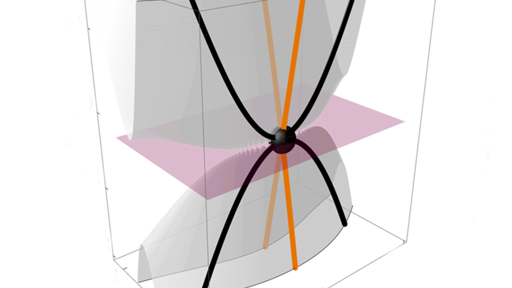The important thing here is that this is about a quasi particle, something that behaves sort of like a particle but is not (like a hole in the electron distribution), in a 2D crystal lattice. This only happens because the lattice is not isotropic, you see a different pattern depending in the direction you look, so having properties change with direction is not totally unexpected. We already have materials with anisotropic thermal conductivity for example.
This won’t happen in vacuum as vacuum is isotropic.
this is such an important thing to note that i feel the headline is just outright a lie
Finally some quality content.
I’m not sure what it would be used for but this is a brand new compound into humanities toolbox that advances physics at the same time. Unexplained phenomena that is also confirming a particle theorised 16y ago. Give Nobel please.
This is how we get to warp drive… Make it so number 1.
We might be able to make a warp drive within the crystal structure. 🫠
An uneducated hypothesis: have a bunch if these particles move back and forth in unison => directional force using only energy => space travel with infinite fuel
Only caveat is that we have to change everyone into fermions temporarily lol
Just a minor scientific hurdle, I’m sure they’ll figure it out in the upcoming weeks.
I like quality content, even if I can’t understand sometimes
Explain yourself immediately.
They have played us for absolute fools.
- Find shiny rock.
- Make rock cold.
- Place cold rock in invisible field that can levitate water droplets
- Shine energy on cold rock we can’t even see
How is this not summoning mythical creatures or opening portals to other dimensions?

All I’m saying is things started getting weird after the turned the LHC on
Tales from the Loop…
Is it down? I bet it’s down.
Ooh ah ah ah ah
You gotta get up to get down
if particles only have mass during certain conditions… could particles be used to compute?
We’re talking… 3034 kinda tech here, but, hear me out.
Gravity Vents/ Inertial Damening come to mind. Having momentum moving in one direction but not when reversing would mean infinite acceleration.
The computer you’re using is made out of particles. You have to be more specific.
Hell, if it’s a newer device, it’s a series of switches operating on nearly-single electrons.
…Holy shit
Is it, dangerous to hold this sort of power?
Only if you use generative Ai
Why does this feel like forbidden knowledge
Hmm… is this what could change space-flight? Imagine having a material that is nigh weighless when moving away from gravity but gains mass again when moving towards it. It would make it much more feasible to transport heavier stuff into space.
Misleading headline. Article goes badly wrong in its attempt to ELI5 ……
It’s not “direction”‘that’s affected, but electron transitions to either higher or lower states …… I think. This article is horribly written if they wanted to communicate anything
Edit: the article does link to the original paper but someone else will need to translate that. It looks more like they were able to produce a formerly theoretical quantum particle (not electron) and show weird behavior. I still don’t know what “direction” means, because it’s relative to how its quantum state changes. I don’t think direction means direction in the macro sense but I don’t know what it does mean
I was misled in the posted article with hints about energy levels that reminded of electron shells. The original article makes it clear these are not electrons but talks about quantum states in a vaguely similar way (at least according to my limited understanding)
I don’t think that’s what they’re saying. They’re measuring a property that should scale linearly with Landau levels and the strength of the magnetic field by a known factor. There’s one possible factor for massive particles, and another for massless ones. In this experiment they observed a third value for the factor that lies between those two, one which matches the predictions of these semi-Dirac fermions. The particles in question are electrons in a semi-metal, so I think that can mean actual movement in the sense that we usually think of the word
That said this is waaay beyond my level of physics, even with the professor attempting to dumb it down for us
For sure directions is related to different planes or lines along the crystal.
They quote in the article that when moving in certain directions, the fermion’s energy is completely derived from motion. So it’s essentially taking the m out of E = mc², which is still neat, but not really something you can scale up
It’s been a while since I took a physics class, but I’m pretty sure everything becomes more weightless as it gets farther from a gravitational pull. Things don’t normally become more mass-less though.
Or, is this a “whoosh” moment for me?
The person you replied to said “weight”, but the article - including direct quotes from the professor heading the team that found it - uses “mass” consistently.
If a material made up of quasi-particles is massless when moving away from gravity at ground level, why is the distinction important?
…a material that is nigh weighless when moving away from gravity but gains mass again when moving towards it.
My brain hung a bit in this statement. I suppose I incorrectly interpreted “nigh weightless” as “losing weight”, which is what everything does as it leaves a gravity well.
It’s 4am here and I’m just browsing on my way to the airport, half asleep. So, please feel free to ignore this whole thing.
Unfortunately we can’t just build something out of particles like this. Consider electrons or neutrinos, something similar is what we’re dealing with here.
Unfortunately we can’t just build something out of particles like this.
Yet. We can’t do it yet. Now that we know it’s possible under the right conditions maybe we can figure it out with a century of effort.
A spinning ring or torus of these particles would make a great propulsion system! When moving toward the back of the ship, they’re reaction mass, moving the ship forward. Then they masslessly move back toward the front of the ship. Basically like a rocket that keeps reusing its own exhaust.








